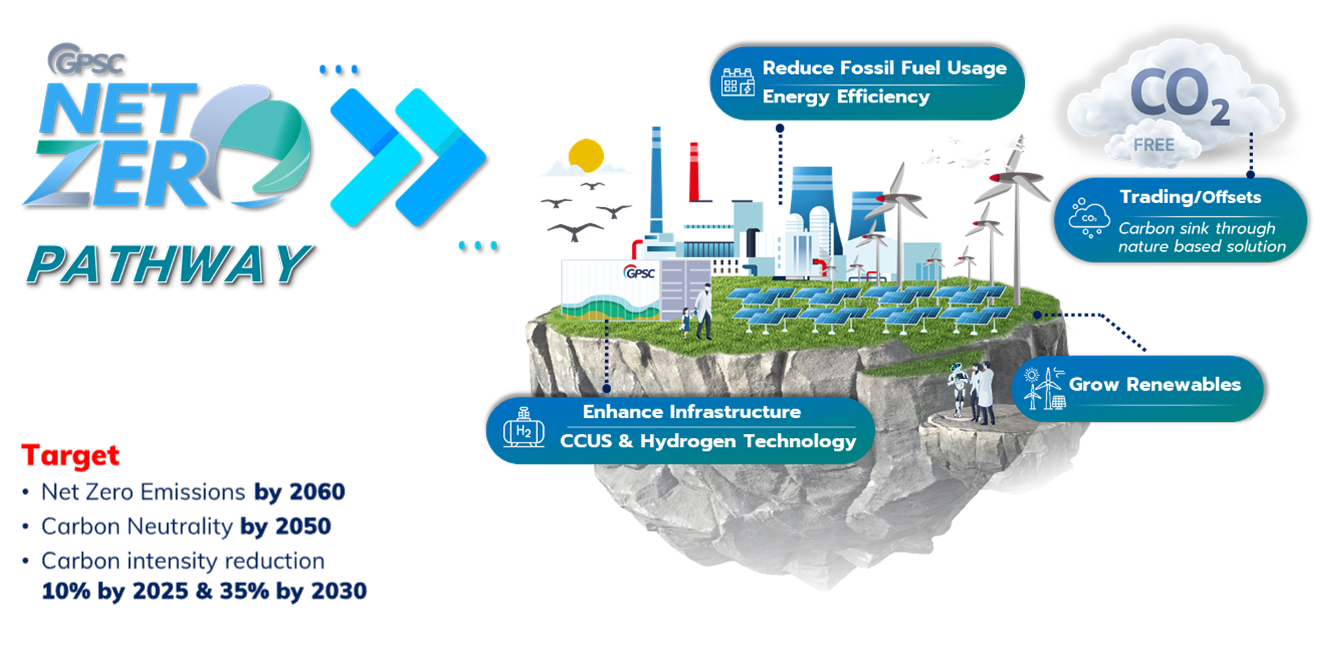| Physical Risks |
| Increased extreme weather events, such as thunderstorms, hailstorms, thunder, and cyclones |
- Such events may damage infrastructures, machinery, and equipment and may result in higher maintenance expenses and disruptions to electricity production, for which GPSC may be penalized and which may adversely impact its revenue.
- Flying debris in a storm may result in injuries.
- Transportation between manufacturers, suppliers, and consumers across the supply chain (especially important products or fuels) may be affected by heavy storms or rain as well as from damage to natural gas pipelines.
- Storm, heavy rainfall and thunder may affect operational continuity and reliability.
- Supplier's ability to supply critical components might be affected.
|
- Implement the emergency response procedure.
- Study the installation and improvement of lightning protection systems (such as surge protectors).
- Conduct training on plant crisis plans to ensure crisis preparedness as well as to limit impacts from an emergency and maintain control.
- Implement proactive crisis management by developing a business continuity management (BCM) system, encompassing key components of the operation.
- Notify responsible personnel of a natural disaster and review details in order to improve the crisis management system.
- Study the installation of technology for reducing convective available potential energy (CAPE) in surrounding areas.
- Maintain high preparedness of Emergency Response Plan
|
| Flood |
- Floods may damage infrastructures, machinery, and equipment and may result in higher maintenance expenses and disruptions to electricity production, for which GPSC may be penalized and which may adversely impact its revenue.
- Employee injuries or fatalities may affect the company’s efficiency and reputation.
- Employees and suppliers may be unable to travel to work or deliver goods, potentially resulting in temporary business suspension among suppliers (especially important products or fuels).
- Floods may force the company to suspend its operations temporarily.
- In the event of a business disruption, maintenance costs for damage to the plant or fines for customers or suppliers may be incurred.
- Dams experience an increase in sediment, which reduces hydroelectric power production efficiency and increases the chance of damage to the turbines at the bottom of the dam.
- Maintenance/ renovation/ replacement costs and insurance expenses may increase.
- Sediments may affect the efficiency of hydropower plants.
- Supplier's ability to supply critical components might be affected.
|
- Closely monitor the water situation in collaboration with representatives of PTT Group Water Management Committee.
- Prescribe business continuity management (BCM) to ensure the ability to effectively respond to issues and maintain operational continuity.
- Maintain high preparedness of Emergency Response Plan
- Create electricity reserve from PEA/EGAT.
- Conduct environmental impact assessments (EIA).
- Manage the situation in accordance with the EIA and other applicable requirements.
- Review risk areas and flood damage and implement adaptation measures in order to minimize risks, such as raising the ground level.
- Build flood barriers (temporary/ permanent).
- Develop and install drainage systems.
|
| Drought |
- Scientific studies based on weather forecasting models indicate that Rayong and Chonburi are likely to experience higher rainfall in the future, thus mitigating the severity of drought impacts to a medium level.
- Once the level of stored water reduces to the shortage level, the company’s operations may face disruption or suspension. Without sufficient water for the plant cooling system, the company may not be able to deliver power to customers, thus affecting its revenue and confidence in the company.
- Production costs may rise due to the need to obtain water supply from other sources.
- The company may need to lease equipment and machinery for converting saltwater into freshwater for cooling purposes.
- Conflict with surrounding communities may ensue if they experience water shortage and their way of life is affected by the company’s water sourcing and consumption. However, by implementing good water management or providing water reservoirs to help communities cope with drought, the company will experience positive feedback.
- Water supplier may not be able to provide water.
|
- Formulate water management plans in preparation for water risks, such as by entering into agreements to purchase demineralized water from other suppliers.
- Develop or improve the production system to reduce water use as well as to reuse and recycle water.
- Install a reverse osmosis (RO) system to convert seawater in areas surrounding the site of operation into freshwater for use during periods of water shortage.
- Allocate budgets to construct water reservoirs and rainwater collection systems for use in dry seasons as an emergency backup supply, capable of storing sufficient water for three days of operations.
- Keep track of water levels in surrounding areas.
- Conduct a wastewater treatment project to obtain water for cooling.
- Expand water management projects to neighboring areas in collaboration with provincial administrative organizations and other agencies within Map Ta Phut Industrial District.
- With good water management, the company can capitalize on the opportunity to sell water to customers experiencing water shortage to generate more income.
- Reduce water consumption
|
| Increasing mean temperatures |
- The increased average surface temperature can reduce electricity production and distribution efficiency and negatively affect confidence in the company.
- The cooling efficiency of water reservoirs is significantly reduced, causing water use to increase.
- The increased rate of evaporation in water reservoirs can lead to a water shortage.
- Solar panel efficiency is reduced.
|
- Conduct regular inspection of machinery on the site of operation.
- Enhance infrastructure and machinery to improve their resistance to higher temperatures.
- Install water sprayers to reduce temperatures during power production.
- Adjust plants according to the situation (short-term adaptation).
- Find new avenues for investment to increase electricity production outside areas facing risks of higher surface temperatures.
|
| Transitional Risks |
| Changes in stakeholder behaviors and expectations (concerns and negative opinions) |
- Major international investors expect that the company has well-defined plans to cope with the impacts of climate change. These investors may pull out their investment if the company continues to have fossil fuel-based production in its portfolio.
- Stakeholders are growing more conscious of and concerned with GHG-producing pollutants from the use of fossil fuels, which negatively impact climate change.
- Some types of renewable energy power plants (such as hydroelectric power plants) require a large area for dam construction and adjustment of the water flow, which may impact the ecosystem and lead to displacement and conflict between communities and the company.
- Failure to fulfill company's commitments and target will cause reputational damage
- Negative reputation for carbon intensive business
|
- GPSC has participated in the low-carbon and sustainable business evaluation by the Thailand Greenhouse Gas Management Organization and has received a low-carbon and sustainable business award for three consecutive years, thus fostering confidence among stakeholders.
- Closely monitor the operation of the operating sites to keep track of environmental and social impacts to minimize risks to the corporate image when the company begins operating a new power plant or acquires a fossil fuel-based power plant.
- Establish GHG emission reduction targets and climate commitments.
- Stop increasing fossil fuel-based production to balance the portfolio.
- Increase renewables-based production.
- Carry out CCS or CCUS projects.
- Research hydrogen fuel technologies.
- Support the activities of surrounding communities.
- Improve or optimize production efficiency to reduce resource consumption and GHG emissions.
|
| Changes in climate-related law and regulations |
- GPSC may be included in an emission trading scheme (ETS) or a cap-and-trade scheme in Thailand and in countries that develop such schemes. The company may lose investment privileges from investment promotion agencies if it fails to comply with relevant laws and regulations.
- In response to the potential nationwide enforcement of emission trading schemes in the future, the company may need to formulate an approach to reducing power production costs.
- An emission trading scheme may facilitate and accelerate the company’s energy transition.
- GPSC may be affected by carbon taxes, which increase operational costs, such as compliance expenses and insurance premiums.
- GPSC benefits from investment promotion privileges due to investment in alternative low-carbon technologies that help lower the overall emissions of the company’s power plants.
- Increase in low carbon fuel (e.g. natural gas) price due to high resource competition
|
- Monitor Thailand’s electricity production capacity development plans to keep track of changes in domestic carbon pricing as well as domestic emission trading policies.
- Allocate budgets for the organization’s energy transition in line with Thailand’s new NDCs, such as a plan to expand renewables-based electricity production capacity for 2022-2030.
- Adopt internal carbon pricing.
- Establish short-term and long-term GHG emission reduction targets.
- Increase renewables-based electricity production capacity through domestic investments according to the Alternative Energy Development Plan (AEDP) and through international investments through GRSC, such as investments in AVAADA in India and GRP in Taiwan and Vietnam.
- Phasing down coal power
- Improve and develop fossil fuel power plants with advanced technology to optimize energy efficiency and reduce GHG emissions.
- Discontinue the operation of fossil fuel power plants upon the completion of their lifespan.
- Apply CCS and CCUS technology and hydrogen fuels.
- Develop other products and services, such as smart grids, energy storage systems, smart energy solutions, and grid management.
- Conduct projects that utilize nature-based solutions, such as reforestation projects.
- Research and prepare for carbon taxes in the future.
|
| Change in low carbon technology |
- CCS and blue hydrogen technologies can help organizations significantly reduce their GHG emissions and support the achievement of net-zero emission targets.
- Without new energy management services, such as the installation of renewable energy systems and smart grids – micro grids, the company may lose an opportunity to meet the needs of new customers.
- Given significant changes Thailand’s power distribution system is expected to undergo in the future, the company is looking to adopt blockchain technology to effectively monitor and track the energy sources utilized for electricity generation, as failure to do so may negatively affect customer satisfaction and lead to a competitive disadvantage.
- Delayed business transformation may lead to failure to capture new demands e.g. renewables, smart grid, microgrid.
- Delayed adoption of new technologies may cause customers dissatisfaction compared to our competitors
|
- Allocate budgets for research and development of new technology that promotes the achievement of the net zero emission target and the creation of new market opportunities.
- Expand renewables-based power production in support of the net zero emission target.
- Increase the publicization of the services of Combined Heat and Power Producing Company Limited (CHPP), a subsidiary of GPSC Group and a smart energy solution provider.
- Conduct public relations and produce environmentally friendly batteries, which are expected to see high growth in the future.
- Collaborate with universities and partners to test new innovations for further research and development prior to commercial production (open innovation management)
- Increase the proportion of renewable energy and reduce the proportion of conventional energy (fossil fuel)
|
| Changes in consumer behavior |
- Due to the current situation and global pressure for GHG emission reduction, consumers have grown more interested in utilizing electricity produced from renewable energy in order to avoid contributing to such emissions. If the company continues to rely heavily on fossil fuels and delays decarbonization in power production, this may lead to a decrease in purchasing volume, customer satisfaction, and ultimately impact the company’s revenue. However, the company may create a business opportunity by investing in power production technology that utilizes low GHG-emitting renewable energy.
|
- Invest in increasing the proportion of renewables-based electricity production through the acquisition of foreign renewable energy companies, resulting in increased renewable energy production capacity.
- Invest in innovation research and development to support new businesses in the future, such as energy storage systems and energy management systems.
- Adjust the business model to meet customer needs with a diverse range of services and products.
- Conduct feasibility studies on a transition to smart grid systems in Thailand.
|


























